Muscle Insider
New member
Of all the instruments designed to help soothe your body, muscle group by muscle group, after a training session, two have risen to the forefront. In the workout recovery world, the battle of massage guns versus foam rollers is almost as intense as the deep tissue massages they can give you. These noteworthy recovery tools both offer tension...
The post Massage Gun Vs. Foam Roller — Which Is Better for Strength Athletes? appeared first on BarBend.
Of all the instruments designed to help soothe your body, muscle group by muscle group, after a training session, two have risen to the forefront. In the workout recovery world, the battle of massage guns versus foam rollers is almost as intense as the deep tissue massages they can give you. These noteworthy recovery tools both offer tension relief — but who does it better?
Whether you’re contending with tight muscles or just need an intense massage for multiple areas of your body, you might want to approach your post-workout routine with different types of massage therapy. Both the foam roller and massage gun can relax your muscles but with relaxation through drastically different means.
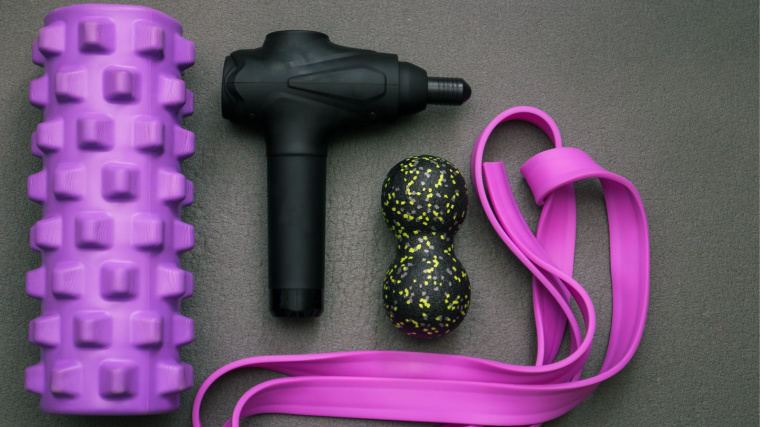 Credit: Fire-n / Shutterstock
Credit: Fire-n / Shutterstock
Should you lie down and offer yourself some deep massages on a foam roller, or take aim at your target muscles with a massage gun? Here, you’ll fully explore the nuances of foam rollers and massage guns to decide which is best to help offer that sweet pain relief after training.
Editor’s Note: The content on BarBend is meant to be informative in nature, but it should not be taken as medical advice. When starting a new training regimen and/or diet, it is always a good idea to consult with a trusted medical professional. We are not a medical resource. The opinions and articles on this site are not intended for use as diagnosis, prevention, and/or treatment of health problems. They are not substitutes for consulting a qualified medical professional.
Meet the Expert
Heather Asti, PT, MPT, has been a practicing physical therapist for nearly two decades in the outpatient orthopedic world. In addition to her Master of Physical Therapy degree from Wayne State University, Asti owns certifications in Instrument-Assisted Soft Tissue Mobilization, and Prenatal and Postpartum Care. She is also an APTA Advanced Certified Clinical Instructor.
Foam Roller Vs. Massage Gun — Which Is Better?
Whether you prefer a foam roller or a massage gun may be a matter of personal taste, but is one objectively better than the other? Certainly, health history, personal flexibility, and sheer preference may factor into your decision.
We’ll lay out the biggest factors to consider when weighing what to buy for your home gym here.
The Research
Many proponents of foam rollers swear by their recovery benefits. Some research supports these claims, with limited-scope studies suggesting that foam rolling (especially combined with static stretching) may help prevent delayed-onset muscle soreness (DOMS) and increase range of motion over time. (1)(2)
However, larger studies suggest that athletes using foam rollers before working out received negligible performance benefits, along with some limited flexibility improvements. (3) (4) Still, foam rolling as part of a dynamic warm-up may help muscle recovery more than foam rolling in during a cool down. (4)
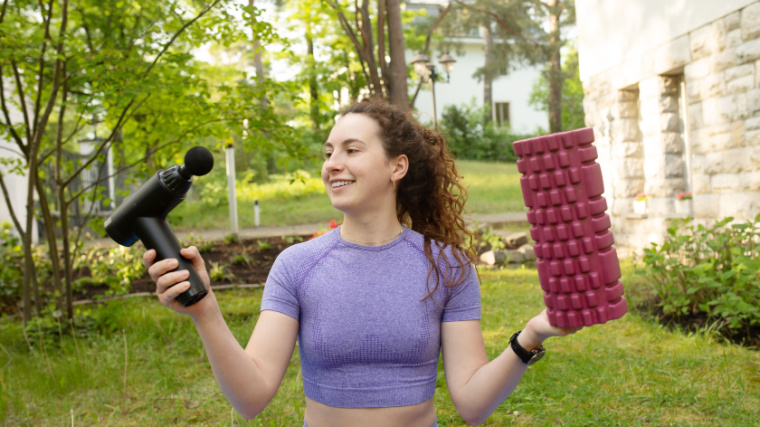 Credit: LTim / Shutterstock
Credit: LTim / Shutterstock
[Read More: Omega 3 Benefits — More Muscle, Better Recovery, and Enhanced Endurance]
Research suggests that massage guns may offer improvements to muscle strength, range of motion, and flexibility while reducing musculoskeletal pain. (3) Another study found that massage guns may be able to reduce muscle soreness without compromising the strength of the muscles. (5)
Key Similarities
Foam rollers and massage guns couldn’t look any more different — but in their intended purpose, they’re actually quite similar.
“Both implements use physical pressure or force to induce their positive effects on the body,” Asti explains to BarBend. “Each technique creates pressure on the skin, fascia, muscles, and tendons, and the repeated pressure increases blood flow. They both improve local blood flow in the soft tissues and can create short-term flexibility gains. In addition, they can both aid in the reduction of DOMS.”
In other words, they’re used for the same purposes and can help get you closer to similar ends.
Key Differences
Basic foam rollers are immobile pieces of foam that you move your body against in order to give yourself an attempted self-myofascial release and relieve tension. Massage guns are automated, electronic devices that give you a percussive massage via powerful vibrations in a very specific location.
The differences between the two are more than just skin deep.
“Foam rolling will likely require a longer duration to produce the effect,” Asti says, “compared to the more high-intensity and high-frequency massage gun — which only requires a few short minutes of application.”
What Is a Foam Roller?
A foam roller is a piece of sturdy cylindrical foam, normally either 24 or 36 inches long and five or six inches in diameter. Depending on the foam roller developer or manufacturer, the surface may be ridged or contoured to dig deeper into certain muscles or pressure points.
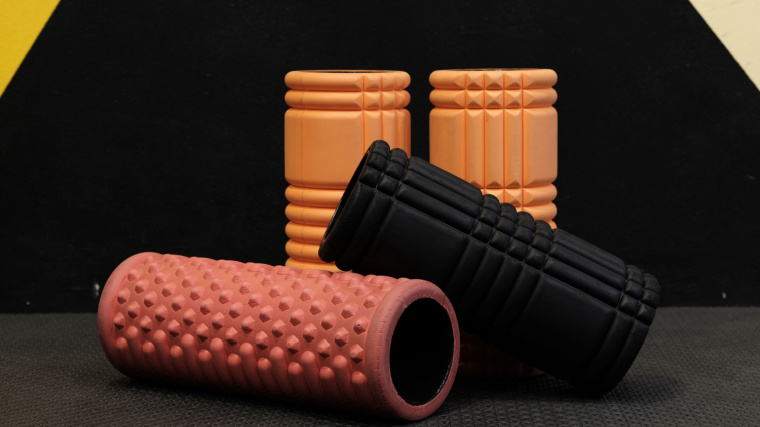 Credit: Ratchayong Bannakan / Shutterstock
Credit: Ratchayong Bannakan / Shutterstock
[Read More: The 8 Best Knee Sleeves You Can Buy]
There are also specialty vibrating foam rollers or those that administer cold or heat to the muscles as well. All of these features are dedicated to giving even more relief to your muscles.
How Do Foam Rollers Work?
Foam rollers don’t accomplish their tasks through a flourish of activity. Instead, when you use a foam roller, you’ll spend the bulk of your time with your body on top of the roller, slowly working your individual muscles over the roller until you’ve achieved your goal.
“Foam rollers use variations in the user’s body weight — depending on the technique and position of the user — to create pressure that might mimic deep pressure massage or trigger point therapy,” says Asti.
When To Use a Foam Roller
The easy accessibility of foam rollers lets you plant one in the middle of your living room floor and go to work on your muscles any time you’re gearing up for an at-home workout.
[Read More: The 11 Best Post-Workout Supplements]
“Foam rolling is best utilized before exercise to create increased warmth and blood flow, and to induce increased flexibility,” says Asti. “It is also great to do after exercise to reduce muscle soreness. Ideally, foam rolling should be a regular part of your workout program to be most effective.”
How To Use a Foam Roller
Now that you’re prepared to engage with your foam roller for the sake of alleviating or preventing some muscle soreness, what is the best way to go about it? First things first: it shouldn’t hurt. “It’s important to note that foam rolling should not be painful,” Asti explains. “The user should aim to create a moderate to intense, but tolerable, pressure in the muscle.”
“A session should begin with slowly rolling the length of the muscle to identify the tender points, then holding on each point for 30 to 60 seconds or until the tenderness subsides,” explains Asti.
Keep in mind that these positions may be difficult to get into and maintain. Be sure to support your weight on your hands, elbows, and legs as needed. Once you find your position, gradually shift your weight to put more pressure on your desired muscle.
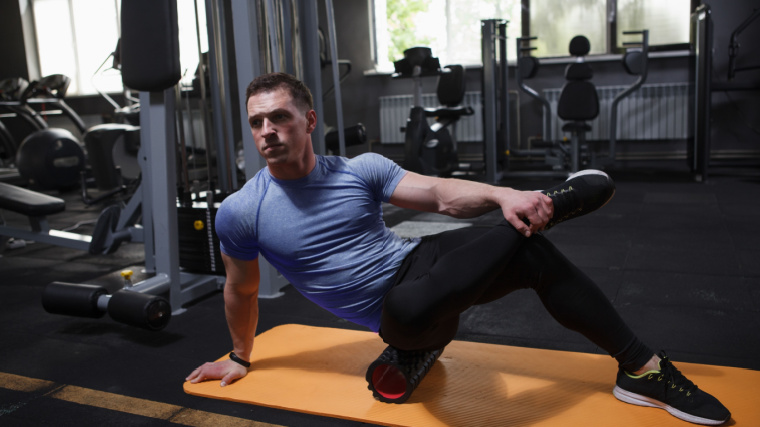
[Read More: The Best Full-Body Bodybuilding Workout for Beginner to Advanced Lifters]
But just because you’ll be exploring the length of your muscle doesn’t mean you can go all over with a foam roller.
According to Asti, “Foam rollers should be applied to soft tissue only, avoiding bony areas like elbows, knees, and lateral shoulders as well as areas where nerves may be close to the surface such as directly behind the knees, in the underarms, and around the elbow.”
What Is a Massage Gun?
A massage gun is an electric rechargeable — and expensive — device with a protruding rubber attachment. This attachment delivers patterned pulses of concussive energy to your muscles — in other words, it vibrates, hard.
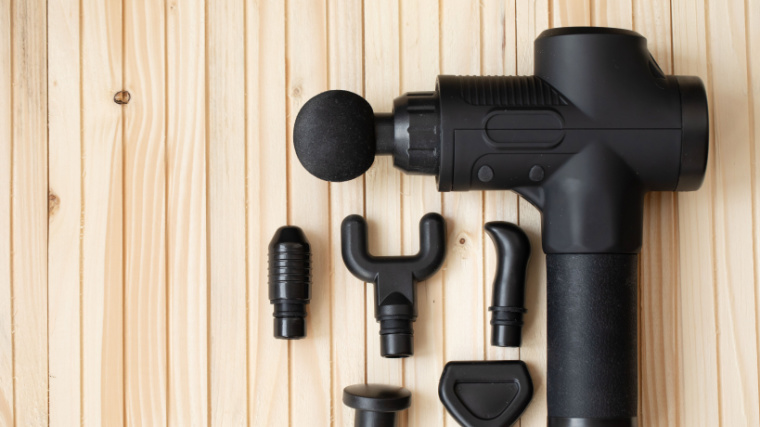 Credit: LTim / Shutterstock
Credit: LTim / Shutterstock
[Read More: The 10 Best Grip Strengtheners On the Market]
Many massage guns allow you to modify the force and frequency of the reverberations, enabling you to customize the experience. Because the part of the massage gun that actually contacts your muscles is relatively small — only around a couple of inches in diameter — you’ll be concentrating all the vibration and pressure on a small surface area at a time.
How Do Massage Guns Work?
While the mechanism of massage guns seems complex, especially compared to the simple foam roller, their work is very straightforward.
“Massage guns — depending on the type — use vibration or percussion on the tissue, and the forces are typically modifiable by turning the device “up” or “down” in terms of the frequency, amplitude, and torque,” explains Asti. “Depending on the type of massage gun, the intensity can be quite high and caution should be used in the presence of injured or strained tissues.”
When To Use a Massage Gun
If you can afford to own one, you can use a massage gun at any time. Many strength athletes use them before or after their workouts to help out with warming up and cooling down their muscles.
[Read More: The 5 Best Fitness Trackers]
“Just like foam rollers, massage guns can be useful both before and after exercise depending on the desired effect,” says Asti. “Massage guns are a great way to reach muscles and tissues not easily manipulated with a foam roller, and are a good option for those who cannot get into positions required for proper use of a foam roll.”
How To Use a Massage Gun
Massage guns are relatively simple to use. You just need to manually apply the working end of the massage gun to the targeted area and activate the on button. Still, it’s best not to haphazardly sweep a massage gun over your body.
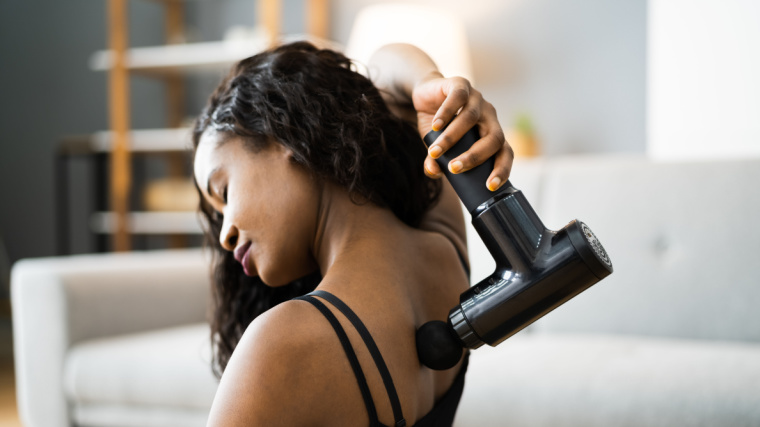 Credit: Andrey_Popov / Shutterstock
Credit: Andrey_Popov / Shutterstock
[Read More: Best Posture Correctors That Provide Posture Support]
“The best way to use a massage gun is to begin with a lower intensity to the desired muscle, sweeping up and down the length of the tissues. Any areas of tenderness or perceived tightness can then be addressed by either turning up the intensity and sweeping the area OR holding a lower intensity directly over the tender area for 10 to 20 seconds.”
Your Takeaways
Foam rollers and massage guns are both common choices for preparing your body for training and kickstarting your muscle recovery afterward. When you’re looking to alleviate muscle pain or are aiming to give different areas of the body a massage without help from a spotter, both tools come in very handy.
If your body (and wallet) are open to different options, Asti recommends a massage gun over even the best foam roller for three reasons.
“Massage guns are significantly more portable than foam rollers, their adjustable pressure offers more versatility for a variety of users and conditions, and they are more suitable for persons who are not able to get on or off a floor,” Asti explains. “Massage guns can also be applied one-handed by the user to reach almost any point on the body, or can be applied by someone else.”
The Ultimate Winner Needs to Be You
Want a sports massage without actually needing to go get a massage? Both the massage gun and foam roller offer a quick, convenient, and easy-to-learn way to give your muscles a massage independently.
While the massage gun may have more research stacked on its side, if the foam roller is more financially accessible, enjoyable, and relaxing to you, roll on away — it’s about your recovery, after all.
FAQs
Here are some answers to help you make a quick decision when choosing between a foam roller or a massage gun.
Is a massage gun better than foam rolling? [/b] Both recovery tools may produce similar physiological responses, but a massage gun may produce that response more quickly, and with greater precision. However, some users may not enjoy the pounding feeling of the massage gun, which ultimately renders the decision a personal preference.
What is the difference between a foam roller and a massage gun? [/b] A foam roller is a simple cylindrical device used to apply pressure to your muscles while your body rolls or rocks across its surface. A massage gun is a mobile device that similarly releases muscle tension by administering concussive pulses and reverberations to a more precise area.
Which device is more effective at relieving muscle tension?[/b] Between the two devices, research suggests that the massage gun may be more effective at relieving muscle tension. This is due to its direct contact and its precise, repeated administration of effective pressure. While some research suggests that foam rollers may also be effective, this research is thus far largely limited to smaller studies.
References
[*]Pearcey GE, Bradbury-Squires DJ, Kawamoto JE, Drinkwater EJ, Behm DG, Button DC. Foam rolling for delayed-onset muscle soreness and recovery of dynamic performance measures. J Athl Train. 2015 Jan;50(1):5-13.
[*]Škarabot J, Beardsley C, Štirn I. Comparing the effects of self-myofascial release with static stretching on ankle range-of-motion in adolescent athletes. Int J Sports Phys Ther. 2015 Apr;10(2):203-12.
[*]Konrad A, Nakamura M, Behm DG. The Effects of Foam Rolling Training on Performance Parameters: A Systematic Review and Meta-Analysis including Controlled and Randomized Controlled Trials. Int J Environ Res Public Health. 2022 Sep 15;19(18):11638.
[*]Wiewelhove T, Döweling A, Schneider C, Hottenrott L, Meyer T, Kellmann M, Pfeiffer M, Ferrauti A. A Meta-Analysis of the Effects of Foam Rolling on Performance and Recovery. Front Physiol. 2019 Apr 9;10:376.
[*]Sams L, Langdown BL, Simons J, Vseteckova J. The Effect Of Percussive Therapy On Musculoskeletal Performance And Experiences Of Pain: A Systematic Literature Review. Int J Sports Phys Ther. 2023 Apr 1;18(2):309-327.
[*]Martin, J. (2021, January 20). A critical evaluation of percussion massage gun devices as a rehabilitation tool focusing on lower limb mobility: A literature review.
Featured Image: Fire-n / Shutterstock
The post Massage Gun Vs. Foam Roller — Which Is Better for Strength Athletes? appeared first on BarBend.
Click here to view the article.
The post Massage Gun Vs. Foam Roller — Which Is Better for Strength Athletes? appeared first on BarBend.
Of all the instruments designed to help soothe your body, muscle group by muscle group, after a training session, two have risen to the forefront. In the workout recovery world, the battle of massage guns versus foam rollers is almost as intense as the deep tissue massages they can give you. These noteworthy recovery tools both offer tension relief — but who does it better?
Whether you’re contending with tight muscles or just need an intense massage for multiple areas of your body, you might want to approach your post-workout routine with different types of massage therapy. Both the foam roller and massage gun can relax your muscles but with relaxation through drastically different means.

Should you lie down and offer yourself some deep massages on a foam roller, or take aim at your target muscles with a massage gun? Here, you’ll fully explore the nuances of foam rollers and massage guns to decide which is best to help offer that sweet pain relief after training.
Editor’s Note: The content on BarBend is meant to be informative in nature, but it should not be taken as medical advice. When starting a new training regimen and/or diet, it is always a good idea to consult with a trusted medical professional. We are not a medical resource. The opinions and articles on this site are not intended for use as diagnosis, prevention, and/or treatment of health problems. They are not substitutes for consulting a qualified medical professional.
- Meet the Expert
- Foam Roller Vs. Massage Gun — Which Is Better?
- What Is a Foam Roller?
- How Do Foam Rollers Work?
- When To Use a Foam Roller
- How To Use a Foam Roller
- What Is a Massage Gun?
- How Do Massage Guns Work?
- When To Use a Massage Gun
- How To Use a Massage Gun
- Your Takeaways
- Frequently Asked Questions
Meet the Expert
Heather Asti, PT, MPT, has been a practicing physical therapist for nearly two decades in the outpatient orthopedic world. In addition to her Master of Physical Therapy degree from Wayne State University, Asti owns certifications in Instrument-Assisted Soft Tissue Mobilization, and Prenatal and Postpartum Care. She is also an APTA Advanced Certified Clinical Instructor.
Foam Roller Vs. Massage Gun — Which Is Better?
Whether you prefer a foam roller or a massage gun may be a matter of personal taste, but is one objectively better than the other? Certainly, health history, personal flexibility, and sheer preference may factor into your decision.
We’ll lay out the biggest factors to consider when weighing what to buy for your home gym here.
The Research
Many proponents of foam rollers swear by their recovery benefits. Some research supports these claims, with limited-scope studies suggesting that foam rolling (especially combined with static stretching) may help prevent delayed-onset muscle soreness (DOMS) and increase range of motion over time. (1)(2)
However, larger studies suggest that athletes using foam rollers before working out received negligible performance benefits, along with some limited flexibility improvements. (3) (4) Still, foam rolling as part of a dynamic warm-up may help muscle recovery more than foam rolling in during a cool down. (4)

[Read More: Omega 3 Benefits — More Muscle, Better Recovery, and Enhanced Endurance]
Research suggests that massage guns may offer improvements to muscle strength, range of motion, and flexibility while reducing musculoskeletal pain. (3) Another study found that massage guns may be able to reduce muscle soreness without compromising the strength of the muscles. (5)
Key Similarities
Foam rollers and massage guns couldn’t look any more different — but in their intended purpose, they’re actually quite similar.
“Both implements use physical pressure or force to induce their positive effects on the body,” Asti explains to BarBend. “Each technique creates pressure on the skin, fascia, muscles, and tendons, and the repeated pressure increases blood flow. They both improve local blood flow in the soft tissues and can create short-term flexibility gains. In addition, they can both aid in the reduction of DOMS.”
In other words, they’re used for the same purposes and can help get you closer to similar ends.
Key Differences
Basic foam rollers are immobile pieces of foam that you move your body against in order to give yourself an attempted self-myofascial release and relieve tension. Massage guns are automated, electronic devices that give you a percussive massage via powerful vibrations in a very specific location.
The differences between the two are more than just skin deep.
“Foam rolling will likely require a longer duration to produce the effect,” Asti says, “compared to the more high-intensity and high-frequency massage gun — which only requires a few short minutes of application.”
What Is a Foam Roller?
A foam roller is a piece of sturdy cylindrical foam, normally either 24 or 36 inches long and five or six inches in diameter. Depending on the foam roller developer or manufacturer, the surface may be ridged or contoured to dig deeper into certain muscles or pressure points.

[Read More: The 8 Best Knee Sleeves You Can Buy]
There are also specialty vibrating foam rollers or those that administer cold or heat to the muscles as well. All of these features are dedicated to giving even more relief to your muscles.
How Do Foam Rollers Work?
Foam rollers don’t accomplish their tasks through a flourish of activity. Instead, when you use a foam roller, you’ll spend the bulk of your time with your body on top of the roller, slowly working your individual muscles over the roller until you’ve achieved your goal.
“Foam rollers use variations in the user’s body weight — depending on the technique and position of the user — to create pressure that might mimic deep pressure massage or trigger point therapy,” says Asti.
When To Use a Foam Roller
The easy accessibility of foam rollers lets you plant one in the middle of your living room floor and go to work on your muscles any time you’re gearing up for an at-home workout.
[Read More: The 11 Best Post-Workout Supplements]
“Foam rolling is best utilized before exercise to create increased warmth and blood flow, and to induce increased flexibility,” says Asti. “It is also great to do after exercise to reduce muscle soreness. Ideally, foam rolling should be a regular part of your workout program to be most effective.”
How To Use a Foam Roller
Now that you’re prepared to engage with your foam roller for the sake of alleviating or preventing some muscle soreness, what is the best way to go about it? First things first: it shouldn’t hurt. “It’s important to note that foam rolling should not be painful,” Asti explains. “The user should aim to create a moderate to intense, but tolerable, pressure in the muscle.”
“A session should begin with slowly rolling the length of the muscle to identify the tender points, then holding on each point for 30 to 60 seconds or until the tenderness subsides,” explains Asti.
Keep in mind that these positions may be difficult to get into and maintain. Be sure to support your weight on your hands, elbows, and legs as needed. Once you find your position, gradually shift your weight to put more pressure on your desired muscle.

[Read More: The Best Full-Body Bodybuilding Workout for Beginner to Advanced Lifters]
But just because you’ll be exploring the length of your muscle doesn’t mean you can go all over with a foam roller.
According to Asti, “Foam rollers should be applied to soft tissue only, avoiding bony areas like elbows, knees, and lateral shoulders as well as areas where nerves may be close to the surface such as directly behind the knees, in the underarms, and around the elbow.”
What Is a Massage Gun?
A massage gun is an electric rechargeable — and expensive — device with a protruding rubber attachment. This attachment delivers patterned pulses of concussive energy to your muscles — in other words, it vibrates, hard.

[Read More: The 10 Best Grip Strengtheners On the Market]
Many massage guns allow you to modify the force and frequency of the reverberations, enabling you to customize the experience. Because the part of the massage gun that actually contacts your muscles is relatively small — only around a couple of inches in diameter — you’ll be concentrating all the vibration and pressure on a small surface area at a time.
How Do Massage Guns Work?
While the mechanism of massage guns seems complex, especially compared to the simple foam roller, their work is very straightforward.
“Massage guns — depending on the type — use vibration or percussion on the tissue, and the forces are typically modifiable by turning the device “up” or “down” in terms of the frequency, amplitude, and torque,” explains Asti. “Depending on the type of massage gun, the intensity can be quite high and caution should be used in the presence of injured or strained tissues.”
When To Use a Massage Gun
If you can afford to own one, you can use a massage gun at any time. Many strength athletes use them before or after their workouts to help out with warming up and cooling down their muscles.
[Read More: The 5 Best Fitness Trackers]
“Just like foam rollers, massage guns can be useful both before and after exercise depending on the desired effect,” says Asti. “Massage guns are a great way to reach muscles and tissues not easily manipulated with a foam roller, and are a good option for those who cannot get into positions required for proper use of a foam roll.”
How To Use a Massage Gun
Massage guns are relatively simple to use. You just need to manually apply the working end of the massage gun to the targeted area and activate the on button. Still, it’s best not to haphazardly sweep a massage gun over your body.

[Read More: Best Posture Correctors That Provide Posture Support]
“The best way to use a massage gun is to begin with a lower intensity to the desired muscle, sweeping up and down the length of the tissues. Any areas of tenderness or perceived tightness can then be addressed by either turning up the intensity and sweeping the area OR holding a lower intensity directly over the tender area for 10 to 20 seconds.”
Your Takeaways
Foam rollers and massage guns are both common choices for preparing your body for training and kickstarting your muscle recovery afterward. When you’re looking to alleviate muscle pain or are aiming to give different areas of the body a massage without help from a spotter, both tools come in very handy.
- Multiple studies suggest that massage guns may be effective at alleviating muscle soreness and increasing flexibility over time.
- Massage guns tend to be more portable than foam rollers, can be used while seated or standing, and can target your muscles with greater precision.
- Foam rollers are significantly less expensive than massage guns on average, and don’t require batteries or charging.
- Foam rollers offer athletes a potentially relaxing opportunity to mentally and physically prepare for (and start recovering from) their workouts.
- Neither foam rollers nor massage guns should be used against bone; apply them to soft-tissue surfaces only.
If your body (and wallet) are open to different options, Asti recommends a massage gun over even the best foam roller for three reasons.
“Massage guns are significantly more portable than foam rollers, their adjustable pressure offers more versatility for a variety of users and conditions, and they are more suitable for persons who are not able to get on or off a floor,” Asti explains. “Massage guns can also be applied one-handed by the user to reach almost any point on the body, or can be applied by someone else.”
The Ultimate Winner Needs to Be You
Want a sports massage without actually needing to go get a massage? Both the massage gun and foam roller offer a quick, convenient, and easy-to-learn way to give your muscles a massage independently.
While the massage gun may have more research stacked on its side, if the foam roller is more financially accessible, enjoyable, and relaxing to you, roll on away — it’s about your recovery, after all.
FAQs
Here are some answers to help you make a quick decision when choosing between a foam roller or a massage gun.
Is a massage gun better than foam rolling? [/b] Both recovery tools may produce similar physiological responses, but a massage gun may produce that response more quickly, and with greater precision. However, some users may not enjoy the pounding feeling of the massage gun, which ultimately renders the decision a personal preference.
What is the difference between a foam roller and a massage gun? [/b] A foam roller is a simple cylindrical device used to apply pressure to your muscles while your body rolls or rocks across its surface. A massage gun is a mobile device that similarly releases muscle tension by administering concussive pulses and reverberations to a more precise area.
Which device is more effective at relieving muscle tension?[/b] Between the two devices, research suggests that the massage gun may be more effective at relieving muscle tension. This is due to its direct contact and its precise, repeated administration of effective pressure. While some research suggests that foam rollers may also be effective, this research is thus far largely limited to smaller studies.
References
[*]Pearcey GE, Bradbury-Squires DJ, Kawamoto JE, Drinkwater EJ, Behm DG, Button DC. Foam rolling for delayed-onset muscle soreness and recovery of dynamic performance measures. J Athl Train. 2015 Jan;50(1):5-13.
[*]Škarabot J, Beardsley C, Štirn I. Comparing the effects of self-myofascial release with static stretching on ankle range-of-motion in adolescent athletes. Int J Sports Phys Ther. 2015 Apr;10(2):203-12.
[*]Konrad A, Nakamura M, Behm DG. The Effects of Foam Rolling Training on Performance Parameters: A Systematic Review and Meta-Analysis including Controlled and Randomized Controlled Trials. Int J Environ Res Public Health. 2022 Sep 15;19(18):11638.
[*]Wiewelhove T, Döweling A, Schneider C, Hottenrott L, Meyer T, Kellmann M, Pfeiffer M, Ferrauti A. A Meta-Analysis of the Effects of Foam Rolling on Performance and Recovery. Front Physiol. 2019 Apr 9;10:376.
[*]Sams L, Langdown BL, Simons J, Vseteckova J. The Effect Of Percussive Therapy On Musculoskeletal Performance And Experiences Of Pain: A Systematic Literature Review. Int J Sports Phys Ther. 2023 Apr 1;18(2):309-327.
[*]Martin, J. (2021, January 20). A critical evaluation of percussion massage gun devices as a rehabilitation tool focusing on lower limb mobility: A literature review.
Featured Image: Fire-n / Shutterstock
The post Massage Gun Vs. Foam Roller — Which Is Better for Strength Athletes? appeared first on BarBend.
Click here to view the article.

